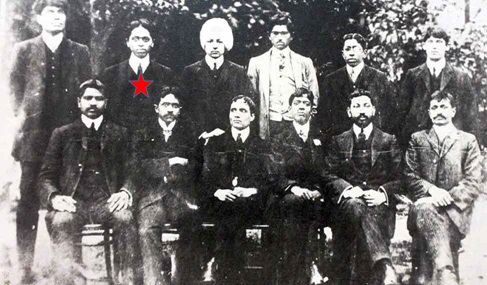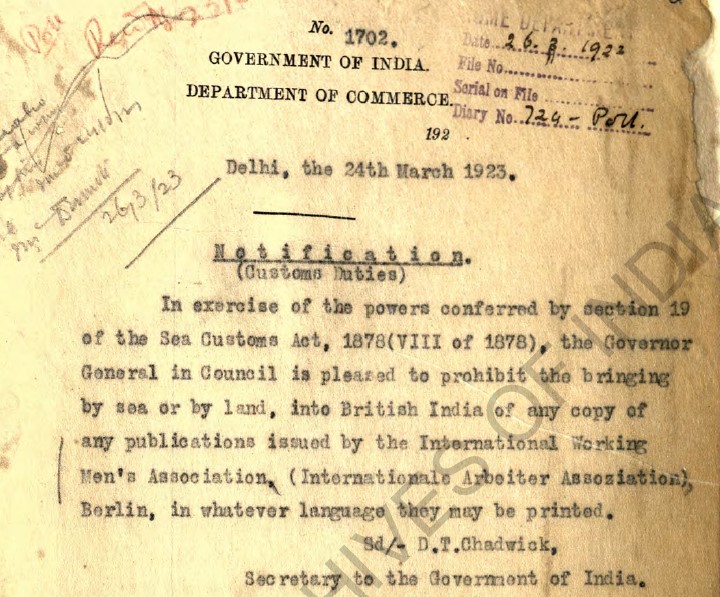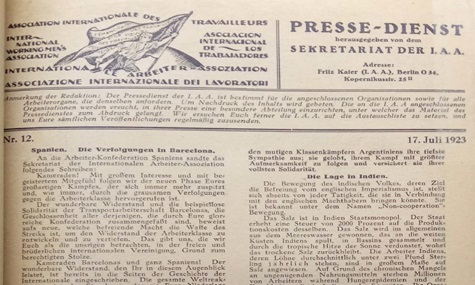M.P.T. Acharya was born on 15th April 1887 in Chennai into a Bhramin family. From early years he was involved in the nationalist struggle. He edited a nationalist magazine for his uncle. When the periodical was suppressed by the colonial authorities Acharya had to escape to French controlled Pondicherry. Sensing he was not safe there he left India and landed in France. He soon moved to London and joined the Indian House with V.D Savarkar, Madan Lal Dhingra and other Indian nationalists. When in 1909 Dhingra assassinated Sir William Hutt Curzon Wyllie the Indian House soon disintegrated.
In 1909, together with another Indian revolutionary by the name of Sukhsagar Dutt, they reached the Riff region in Morocco, with the aim to join the armed rebellion against Spanish colonialism. But this adventure failed, as the Riffan rebels were not willing to recruit the two Indians for suspicion of being spies.
In next few years he visited Berlin, Munich and in November 1911 was in Constantinople to gain Muslim support against the British. In 1912 he moved to New York and in 1914 to San Fransisco, where he edited the Tamil edition of Gadar Party’s periodical. Gadar Party was set up a year ago, with help of his friend and IWW member Har Dayal. Har Dayal had spent time with Emma Goldman and when in 1914 Dayal was deported for being “an anarchist” Emma protested and wrote about it in Mother Earth.
It was during this time Acharya saw the real face of Western Democracies and stood against the notion of nation states. “Is it to make large cities with miserable people, barely eking their existence that we want to have ‘Swaraj’?[1]” He asked.
”I consoled myself by answering that the misery was due to foreign Government, but under Indian Government, it would all vanish, because our countrymen will be friends of the poor when they come to rule. Late on, however, when i went to Europe and saw misery there, my illusions about “National” rule were shattered.”
Acharya spent the World War period in Middle East and in 1917, with Virendranath “Chatto” Chattopadhyaya, attended a socialist peace conference in Stockholm. Where he met prominent Bolshevik leaders and in 1919 met Lenin. In 1920 Acharya helped form and became Chairman of the Communist Party in exile, with M.N.Roy as Secratary. Acharya was kicked out in 1921 for his criticism of the direction CPI was taking under the Comintern and Roy’s autocratic behavior. He attended the Kropotkine’s funeral in Moscow on 13th of February, 1921.

Acharya’s involvement in international anarchist movement was set-off by his disillusionment with the USSR and the whole edifice of Marxist priesthood. He wrote:
“We are Anarchists, because we do not want authoritarianism outside or inside, because to us anti-Marxists, life and society must be, immanently – one indivisible whole impossible of mechanical separation – as the Marxists inorganically think and believe.” “Communism can come only through and beyond Anarchism not before and behind it, as Lenin predicted and died broken-hearted and mad.”
In late December 1922, Acharya and a group of Indians attended the founding meeting of the revived anarchosyndicalist AIT-IWA, with Rudolf Rocker, Augustin Souchy, and Alexander Schapiro as secretaries[2]..
Among the other delegates at the founding meeting was the Japanese anarchist Yamaga Taiji, with whom Acharya remained in touch throughout his life. [3]
The Indians’ first “success,” the secretariat noted sarcastically, was to get IWA literature banned from import into India.
At the suggestion of the AIT-IWA secretariat, a committee of Indians in Europe was subsequently set up with the aim to send anarchist literature to India. While working in complete accordance with the AIT-IWA, the committee was not formally attached to the AIT-IWA. A report in the AIT-IWA magazine “the International” of 1924 expains : “According to the Indian comrades who were in Berlin, an Indian committee was formed to make propaganda of revolutionary unionism in India. The AIT-IWA secretariat supported this committee and tried everything to achieve revolutionary syndicalism in India, and also succeeded in making connections. The AIT-IWA press service was specially edited for India in English and was sent to India and its content was printed in organs of the Indian workers’ organizations. The first « success » we had in India was that the Indian government banned all AIT-IWA communications to India. …” [4]

Indeed, under the Sea Customs Act of 1878, the Government of India prohibited “the bringing by sea or by land into British India of any publications issued by the International Workers Association (Internationale Arbeiter Assoziation), Berlin, in whatever language they may be printed.” [5]

Shortly after the meeting, writing under his middle name Bhayankar, Acharya offered a scathing critique of Roy’s “Program for the Indian National Congress” from December 1922 (Chapter 1). A few months later, Acharya wrote to Chittaranjan “C. R.” Das, editor of the radical Bengali paper Forward, that his political belief was now “anarchism, pure and simple.” During this transition period from communism to anarchism, he contributed to Sylvia Pankhurst’s The Workers’ Dreadnought, and the Berlin-based Russian anarchosyndicalist AIT-IWA paper Rabochii put’ (The Worker’s voice), edited by Grigori Maximoff and Schapiro, and sent his articles to India.

Thanks to Ole Birk Laursen for his inspiring works, which have helped dig up and bring back to light M.P.T. Acharya’s life and ideas !
Souces :
Anarchism, Pure and Simple
MPT Acharya, We Are Anarchists, Essays on Anarchism, Pacifism, and the Indian Independence Movement, 1923–1953 de Ole Birk Laursen
https://theanarchistlibrary.org/library/mpt-acharya-we-are-anarchists
[1] Swaraj can generally mean « self-government » or « autonomy » (swa-« mine », raj « the ruler ») but the word usually refers to Mahatma Gandhi’s concept for Indian independence from foreign domination. Swaraj stresses governance not by hierarchical government, but by self-governance through individuals and community building. The focus is on political decentralization. Since this is against Britain’s followed political and social systems, Gandhi’s concept of Swaraj applied to India, dismisses British political, economic, bureaucratic, legal, military and educational institutions.
[2] Wayne Thorpe, The Workers Themselves: Revolutionary Syndicalism and International Labour, 1913–1923 (Dordrecht; Boston: Kluwer Academic and International Institute of Social History, 1989), 267.
[3] Victor Garcia, Three Japanese Anarchists: Kotoku, Osugi, and Yamaga (London: Kate Sharpley Library, 2000), 23.
[4] « Indien », Die Internationale,no.5, Juni 1925
[5] “Prohibition of the bringing by sea or by land into British India of any copy of any publication issued by the International Working Men’s Association Berlin,” PR_000000192248, file 22–23, NAI.
========
En Español : MPT ACHARYA: del nacionalismo indu al Anarcosindicalismo
========
Text from the pamphlet « From revolutionary syndicalism to anarchosyndicalism: The birth of the International Workers Association (AIT-IWA) »
Table of Contents
- From revolutionary syndicalism to anarchosyndicalism: The birth of the International Workers Association (IWA) in Berlin, 1922
- AIT-IWA’s founding congress twice interrupted by German police.
- Emma Goldman, witness of the AIT-IWA founding Congress.
- MPT Acharya : from Indian nationalism to anarchosyndicalism.
- Kropotkin and the rebuilding of the International Workers Association
- “Sanya” Schapiro, a forgotten figure but instrumental in the birth of the AIT
Pamphlet, 64 pages. You can download the PDF here: http://cnt-ait.info/wp-content/uploads/2022/12/BRO-Arthur-Lehning-birth-of-IWA.pdf
To receive the paper version send an email to contact@cnt-ait.info with your address or write to CNT-AIT, 7 rue St Remesy, 31000 TOULOUSE, FRANCE
2 commentaires sur MPT Acharya : from Indian nationalism to anarchosyndicalism